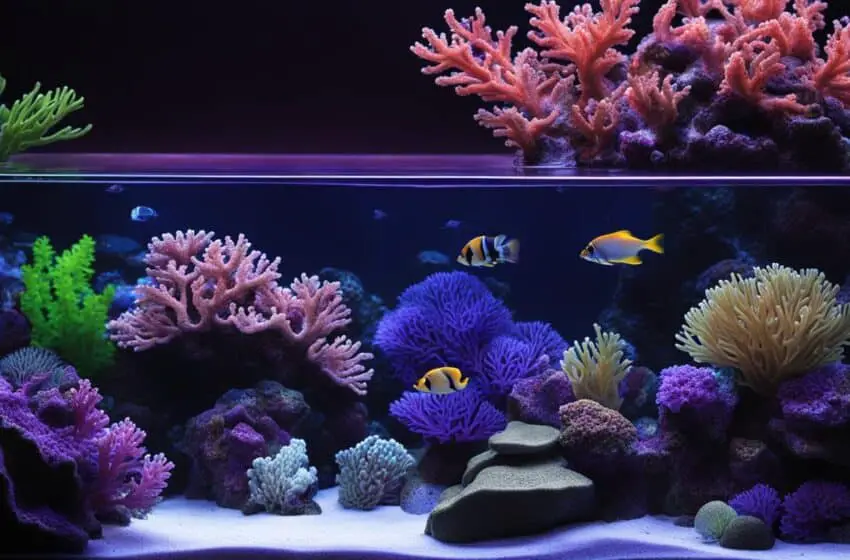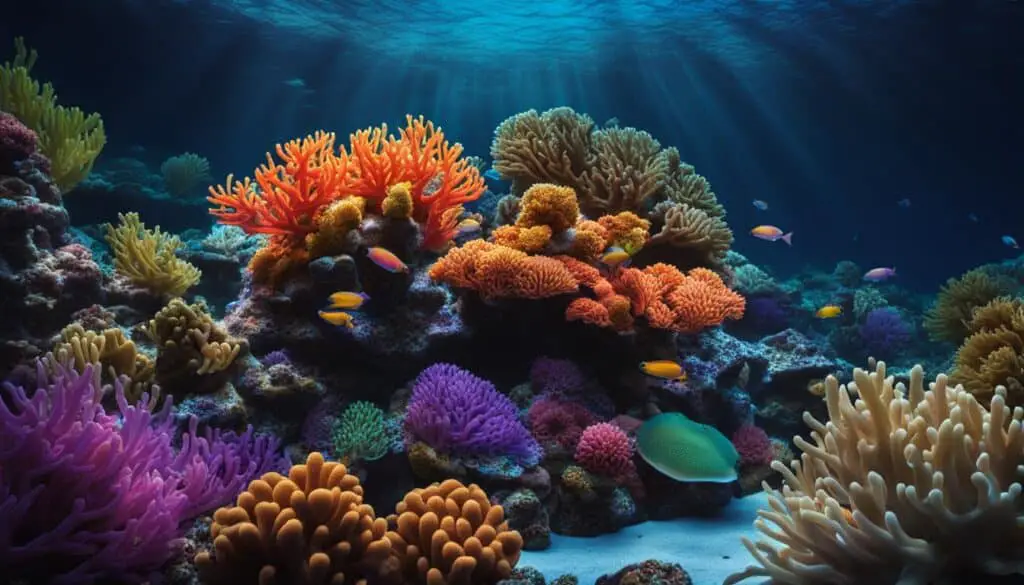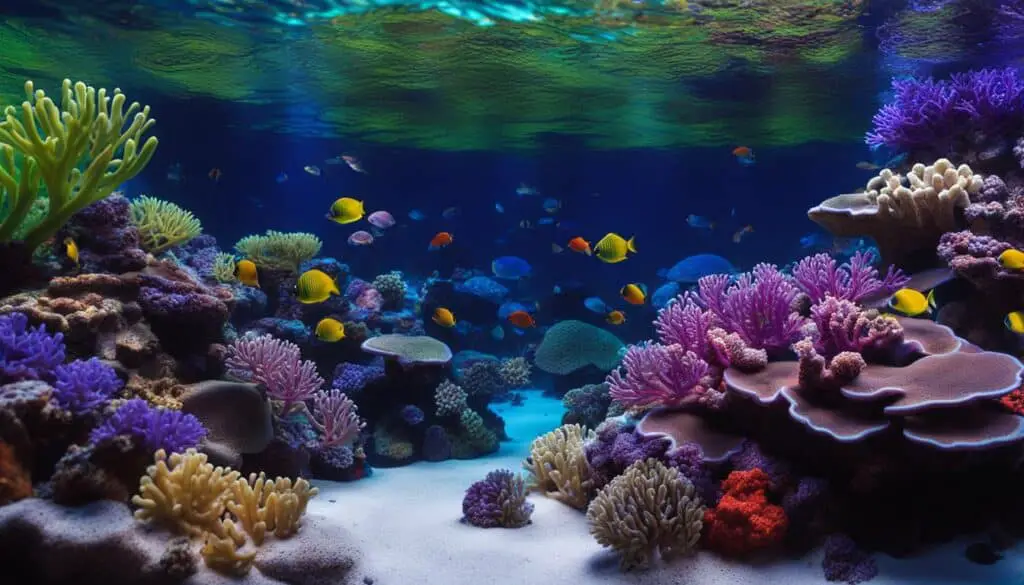Setting the Perfect Light Spectrum for Coral Health

When it comes to maintaining a saltwater aquarium and ensuring the health and vitality of your coral, one of the most important factors to consider is the lighting. With advancements in technology, LED lights have become the preferred choice for most aquarium enthusiasts. However, it is crucial to understand how to properly set the light spectrum to create an optimal environment for your coral. By tuning the spectrum and understanding the specific light wavelength peaks that corals thrive on, you can ensure optimal growth, coloration, and overall health.
Key Takeaways:
- The proper light spectrum is essential for the health and vitality of coral in a saltwater aquarium.
- LED lights provide greater control over the spectrum and intensity of light.
- Stability in the light spectrum is crucial to avoid disrupting coral metabolic processes.
- LED lights can mimic the natural light wavelengths that corals thrive on.
- Trusted manufacturers and presets can help achieve an optimal spectrum for coral health.
Benefits of Stable Spectrum for Coral Health
LED lighting provides aquarium owners with the flexibility to adjust the light spectrum and intensity, giving them greater control over their lighting system. This is a significant advantage compared to traditional lighting options. However, it is crucial to understand the importance of a stable light spectrum when it comes to coral health.
Constantly changing the spectrum or output of LED lights can have detrimental effects on coral vitality. Corals are highly adaptive creatures, but frequent changes in the light spectrum can disrupt their metabolic processes and lead to slow growth, poor coloration, and even mortality.
To ensure the optimal health and well-being of your corals, it is recommended to set the light spectrum to the best of your ability and then leave it unchanged for at least 9-12 months, if not permanently. This stability allows corals to acclimate to their environment and maintain a consistent level of photosynthesis, which is essential for their growth and overall vitality.
Stability is key when it comes to setting the light spectrum. Frequent changes in the spectrum can disrupt coral metabolic processes and lead to slow growth, poor coloration, and even mortality.
By providing a stable light spectrum, you create an environment that closely mimics the natural lighting conditions found in the ocean. This stability allows corals to thrive and flourish, enhancing their vibrant colors and promoting their overall health. Additionally, it can help maintain a visually appealing aquarium display.
Next, we will explore the role of LED lights in creating a usable spectrum and how to achieve an optimal light spectrum for your saltwater aquarium.
Understanding the Role of LED Lights in Creating a Usable Spectrum
Corals have evolved over millions of years to rely on specific light spectrum ranges for their metabolism. LED color channels create precise color spectrum peaks that, when blended correctly, can closely mimic the desired spectrum for coral health. By hitting those color peaks as closely as possible, LED lights can provide the necessary wavelengths for photosynthesis and overall coral vitality. Manufacturers that provide transparent information about their spectrum settings and their research on coral health are trustworthy sources to consider when choosing LED lights for your aquarium.
Benefits of LED Lights for Coral Metabolism
LED lights offer a myriad of benefits for coral metabolism and overall health. Here are some key advantages:
- Energy Efficiency: LED lights are highly energy-efficient, consuming less power while producing higher light output compared to traditional lighting options. This energy efficiency translates into cost savings and reduces the environmental impact of your aquarium.
- Customizable Spectrum: LED lights provide the flexibility to adjust the light spectrum to meet the specific needs of your coral. By fine-tuning the spectrum, you can optimize coral growth, coloration, and overall vitality.
- Long Lifespan: LED lights have a significantly longer lifespan compared to traditional bulbs, reducing the frequency of replacements and maintenance. This ensures consistent and reliable lighting for your coral ecosystem.
- Low Heat Output: LED lights generate minimal heat, preventing temperature spikes in the aquarium. This is vital for maintaining stable water conditions and preventing stress to your coral and other aquatic life.
Investing in high-quality LED lights from reputable manufacturers can significantly enhance the health and vibrancy of your coral. These lights are designed to provide the essential light spectrum ranges that corals require for optimal metabolism and growth.

How to Create an Optimal Spectrum with LED Lights
When it comes to achieving the perfect light spectrum for your aquarium, LED lights provide a versatile solution. LED light manufacturers offer preset options that are designed based on extensive research to ensure the best balance of wavelengths for coral health. These preset options are an excellent starting point for creating an optimal light spectrum.
If preset options are not available, you can consider emulating the successful spectrum settings used by experienced aquarium enthusiasts. Learning from others who have achieved long-term success can be a valuable resource in creating an ideal light spectrum for your aquarium.
To create a spectrum that fosters coral photosynthesis and overall health, it’s essential to pay attention to the UV, violet, blue, white, and cool white color channels. Adjusting these channels can help create a wider violet-blue color peak, which is crucial for providing the necessary wavelengths for coral growth and vitality.
| Color Channel | Adjustment |
|---|---|
| UV | Increase slightly |
| Violet | Increase |
| Blue | Increase |
| White | Maintain a moderate level |
| Cool White | Maintain a moderate level |
By adjusting these color channels, you can create a more balanced spectrum that promotes coral photosynthesis and the overall health of your aquarium. Remember to monitor your coral’s response to the adjusted spectrum and make further tweaks if necessary.
Creating an optimal spectrum for your LED lights is crucial for the health and vibrancy of your coral. Whether you rely on presets provided by the manufacturer or emulate successful spectrum settings, paying attention to the UV, violet, blue, white, and cool white color channels can ensure a spectrum that supports coral growth and vitality.
Spectrum Blending and Eliminating the “Disco Ball Effect”
LED lights have revolutionized the world of aquarium lighting, offering a wide range of benefits over traditional T5 and metal halide bulbs. However, one challenge that LED lights pose is the so-called “disco ball effect.” Unlike traditional bulbs that provided a uniform spectrum, LED lights require blending different LED peaks to emulate a full spectrum of light. While visually these lights may appear blended, upon closer inspection, individual dots or lines of white, blue, green, and red may be visible. This can be distracting and take away from the natural beauty of the aquarium.
To overcome the disco ball effect and create a more visually appealing lighting environment, LED manufacturers have developed techniques such as lens placement or diffusers. These techniques help blend the individual colors together, creating a more seamless and uniform lighting experience. By reducing the visibility of the individual LED peaks, aquarium enthusiasts can enjoy the benefits of LED lights without the distraction of a disco ball effect.
The Importance of Light Intensity
In addition to blending the spectrum, controlling the light intensity is also crucial for maintaining a balanced and pleasing lighting environment. LED lights offer the flexibility to adjust the intensity to suit the needs of the aquarium inhabitants. By finding the right balance between spectrum blending and light intensity, you can create a visually stunning and healthy habitat for your aquatic creatures.
I believe that finding the perfect combination of spectrum blending and light intensity is key to creating a captivating and thriving aquarium. – [Your Name]
Now let’s take a look at a table showcasing the different techniques for spectrum blending and their effectiveness:
| Technique | Effectiveness |
|---|---|
| Lens Placement | Greatly reduces disco ball effect and provides a more blended spectrum |
| Diffusers | Creates a softer and more diffused light, minimizing the visibility of individual LED peaks |
| Reflectors | Enhances light distribution and reduces the appearance of individual LED dots or lines |
By utilizing these techniques and finding the right combination for your specific LED lights, you can achieve a more natural and aesthetically pleasing lighting environment in your aquarium. Now, let’s move on to the next section where we will discuss how to control the light spectrum throughout the day.

Controlling Spectrum Throughout the Day
While there is no definitive evidence on whether changing the spectrum throughout the day has a significant impact on coral health, many reef aquarium owners do it for visual appeal. If you choose to change the spectrum, it is recommended to follow specific guidelines.
Guidelines for Changing the Spectrum:
- Reduce white light during ramp up and ramp down.
- Keep the blues the same.
This strategy can help turbocharge photosynthesis in the morning and allow it to slow down throughout the day. By reducing the white light during the transition periods and maintaining the blues, you provide the necessary wavelengths for coral photosynthesis, promoting their overall health and vitality.
However, it’s important to note that the decision to change the spectrum should be based on personal preference. Experimentation is key to finding the perfect balance that suits the visual appeal you desire for your aquarium while ensuring optimal coral photosynthesis.
Changing the spectrum throughout the day can enhance the visual appeal of your aquarium.
The Importance of Balanced Light Spectrum for Coloration
The lighting in a saltwater aquarium plays a crucial role in the coloration of both fish and corals. Light influences how our eyes perceive colors, and without the right spectrum, certain pigments may not be visible. Achieving vibrant and captivating colors in your aquarium requires understanding the influence of lighting and providing a balanced light spectrum that caters to the specific needs of your corals.
One fascinating aspect of coral coloration is the role of fluorescent proteins. These proteins, present in corals, absorb high-energy blue-violet light and emit lower-energy wavelengths. This process creates the mesmerizing glowing effect that is commonly seen in reef aquariums. To fully experience the beauty of coral coloration and achieve optimal fluorescence, it is important to provide a light spectrum that includes peaks in the violet, blue, and indigo wavelengths.
By providing the right balance of light wavelengths, you can enhance the visibility of pigments and unlock the full potential of your corals’ coloration. Vibrant blues, pinks, greens, and purples can come to life when the lighting conditions mimic their natural habitat.
Creating a Balanced Light Spectrum
When it comes to creating a balanced light spectrum, LED lights offer great flexibility and control. Manufacturers now provide a wide range of options that allow you to fine-tune the light emitted by your aquarium lighting system. By adjusting the intensity and blending different LED color channels, you can create a customized spectrum that highlights the natural colors of your corals.
Here are some key considerations when creating a balanced light spectrum:
- Include peaks in the violet, blue, and indigo wavelengths to enhance fluorescence and coloration.
- Avoid excessive exposure to higher energy light, such as ultraviolet (UV) light, as it can cause stress and bleaching in corals.
- Pay attention to the specific light requirements of different coral species, as their coloration can vary.
- Consult reputable sources, such as scientific studies and experienced aquarium enthusiasts, to gain insights and recommendations for optimal light spectrum settings.
Remember, achieving the perfect balance in your light spectrum may require some experimentation and adjustments. It’s important to monitor the response of your corals closely and make changes accordingly to ensure their well-being.
Proper lighting is not only essential for the well-being of your corals but also enhances the overall visual appeal of your aquarium. The right balance of light spectrum can transform your tank into a mesmerizing underwater paradise, truly showcasing the natural beauty of your coral collection.
“The proper balance of light in a saltwater aquarium is crucial to accentuate the natural coloration of corals and create a stunning visual display.”
Conclusion
Creating the perfect light spectrum for your saltwater aquarium is crucial for maintaining the health and vibrancy of your coral. LED lights offer the flexibility and control to achieve a balanced light spectrum. By setting the spectrum to mimic the natural wavelengths that corals thrive on and providing stability, you can ensure optimal coral growth, coloration, and overall vitality.
When selecting LED lights for your aquarium, it is important to rely on trusted manufacturers who provide transparent information about their spectrum settings and their research on coral health. Experimenting with preset options or emulating successful spectrum settings used by experienced hobbyists can help you find the ideal spectrum for your coral’s needs.
Additionally, consider balancing the light spectrum to enhance fluorescence and color in your aquarium. A spectrum that includes peaks in the violet, blue, and indigo wavelengths can help create a visually stunning and vibrant underwater environment.
By following a saltwater aquarium lighting guide and understanding the importance of the light spectrum, you can create an optimal environment that promotes the health and well-being of your coral, resulting in a beautiful and thriving aquarium.
FAQ
What factors should I consider for maintaining the health of my coral in a saltwater aquarium?
One of the most important factors is the lighting, as it plays a crucial role in the growth and vitality of your coral.
Why are LED lights the preferred choice for saltwater aquarium lighting?
LED lights offer flexibility and control over the light spectrum, allowing for optimal growth and coloration of coral.
Is it advisable to constantly change the light spectrum for my coral?
No, stability is key. Constantly changing the spectrum can disrupt the metabolic processes of coral and lead to poor health.
How can LED lights mimic the natural spectrum that corals thrive on?
LED lights have color channels that can be blended to create precise color spectrum peaks, providing the necessary wavelengths for coral photosynthesis.
What is the “disco ball effect” in LED lights, and how can it be reduced?
The “disco ball effect” refers to the visible individual dots or lines of different LED colors. Manufacturers use techniques like lens placement or diffusers to blend the colors together and reduce the effect.
Should I change the light spectrum throughout the day for visual appeal?
While it does not have a significant impact on coral health, many aquarium owners do it for aesthetic reasons. Guidelines such as reducing white light during ramp up and ramp down can enhance photosynthesis in the morning and allow it to slow down throughout the day.
How does lighting influence the coloration of corals in a saltwater aquarium?
Light influences how our eyes perceive colors, and the right spectrum is crucial for certain pigments to be visible. Fluorescent proteins in corals require a balanced light spectrum for optimal fluorescence and color pop.
How can I create the perfect light spectrum for my saltwater aquarium?
You can rely on the preset options provided by LED light manufacturers or emulate successful spectrum settings used by other aquarium enthusiasts. Balancing the UV, violet, blue, white, and cool white color channels can help create a wider violet-blue color peak, essential for coral photosynthesis.
What is the importance of a balanced light spectrum for coral health?
A balanced light spectrum is crucial for maintaining the health and vibrancy of corals in a saltwater aquarium. LED lights offer flexibility and control to achieve this balance, ensuring optimal growth, coloration, and overall vitality.
Source Links
- https://www.bulkreefsupply.com/content/post/brstv-investigates-lighting-coral-coloration
- https://www.bulkreefsupply.com/content/post/reef-tank-lighting-schedule-what-is-the-deal-spectrum-program-for-your-led-lights-brstv-reef-faqs
- https://www.reef2reef.com/threads/the-optimal-light-spectrum-in-a-reef-aquarium.848925/



